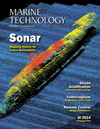
Page 22: of Marine Technology Magazine (March 2014)
Instrumentation: Measurement, Process & Analysis
Read this page in Pdf, Flash or Html5 edition of March 2014 Marine Technology Magazine
Legal Beat The U.S. Coast Guard is planning to widely use sonar to support its maritime security and marine environmental protection missions. The agency currently has limited capabil- ity to detect objects below the water?s surface and relies on others (such as the U.S. Navy or the commercial sector) when such detection is needed.Sonar is an acronym for Sound Navi- gation and Ranging. The principle is similar to radar, used in the atmosphere. While radar uses radio waves, sonar re- lies on sound waves, which propagate much better than radio waves do in wa- ter. There are two major types of sonar ? passive and active. Passive sonar only listens, detecting sounds made by ves- sels, persons, sh and other things in the water, or the water itself (e.g., waves). Active sonar transmits a sound signal that then is re ected off an object with- in range and returns to the transducer. Measuring the time difference between transmission and reception provides an indication of the range of the target. Measuring the angle of the received sig- nal provides an indication of the direc- tion of the target. Sonar transmissions are made in a va- riety of frequencies, depending upon the intended purpose. Low frequency trans- missions have the advantage of very long range. On the other hand, these sonar transmissions can only detect very large objects and with minimal accu- racy relative to range or bearing. Mid- frequency transmissions have a range measured in miles and are able to detect objects such as submarines and large whales with good accuracy relative to range and bearing. This is the type of sonar utilized almost exclusively by the military, having virtually no commercial application. High frequency and ultra- Sonar & the USCG Sonar & the USCG By Dennis Bryant The USCG Plans to Widen its use of the subsea surveillance technology. The question is: is the investment warranted? A civilian contractor steadies a M18 Mod 2 KingÞ sh Unmanned Underwater Vehicle (UUV) as it is lifted with a crane onto the deck of an 11-meter rigid-hull inß atable boat. (U.S. Navy photo by Mass Communication Specialist 2nd Class Blake Midnight/Released) 22 MTRMarch 2014 MTR #2 (18-33).indd 22MTR #2 (18-33).indd 222/21/2014 10:31:12 AM2/21/2014 10:31:12 AM

 21
21

 23
23
